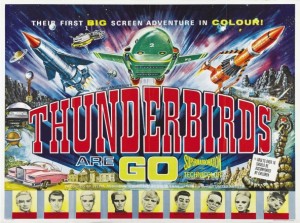1970s: Space gods to Star Wars

So thankfully we didn’t end up here in 2013 being controlled by our artificial intelligence overlords. Unfortunately, we’re unable to chat up Orion dancing girls, either.
From the 1960s onwards, the design of the future took a more realistic turn. We could now actually make spaceships (well rockets), had the money and resources to research into new fields, and eventually concrete over everything. The future in the late 1960s could be argued to be full of dull greys and diesel, as engineering and manufacturing took off in a massive way.
That’s not to say there were not some quirky and fun designs for the future. For those who thought the reality of the late 1960s and early 1970s was plastic and dull, future thinkers on the printed page added glam, built on psychedelic inspiration and vivid colour, to the worlds of tomorrow.
Mind-expanding ideas of secrets, super-gods and aliens are pure Jack Kirby- The idea of giant space gods, superhuman assistance and alien races were greatly influenced by the work of Erich von Danikens book from the 1970s, ‘Chariots of the gods’ in which the author surmised that humanities knowledge was given to use by aliens and that we worshipped then as gods.
Taking this idea of alien races, ‘space based ‘supermen’ and higher beings would not just work in Marvels favour as across at DC Kirby explored the idea of cosmic characters even further under the banner of ‘Jack Kirby’s 4th World’ The first titles from the series consisted of three titles, New Gods, Mr Miracle and The Forever People which were originally intended to be huge mega-series with all the titles linking together in some way and for the books to have a finite lifespan.
The books main themes once again revolved around hidden civilisations and god like creations. With only one book set on earth ‘The Forever People’ the books main role was to tell internal stories of giant alien gods and the battle between good and evil, represented by two planets, the goodies coming from the paradise like New Genesis and the bad guys coming from the industrial hell-like Apokolips. Using advanced technology such as the sentient computers called Mother Boxes and teleport systems called Boom Tubes the comics covered the evil lord of Apokolips Darkseids quest to find the anti-life equation,
Filled with weird and wonderful characters such as Kalibak, Lightray, Big Barda, Granny Goodness and Scott Free aka Mr Miracle the books were off the scale when it came to high-concept sci-fi, intergalactic action and vast space battles that would put Star Wars to shame.
Thunderbirds are gone!
Throughout the 60s and 70s Jerry Andersons work on TV thrilled children and adults alike. Show like Fireball Xl5, Stingray, Thunderbirds, Joe 90 and Captain Scarlet were watched by millions of viewers.
By the early 1970s Anderson moved onto ‘Live Action’ shows such as UFO – Out went ‘Supermarionation’ puppets and in came purple wigs and silver suits. UFO was filmed in 1969-70, and began broadcasting in September 1970 in England and September 1972 in America. The series ran for only a single season, for a total of 26 one-hour color episodes.
By the late 1970s Jerry Anderson productions had all but disappeared from our screens. True there were continual repeats of classic shows but nothing really new. This was because at the time Anderson had taken a very strong interest in the Japanese market. With his futuristic based vehicles, love of technology and team based approach to shows Anderson saw that his style was ideally suited to a huge market that had been bought up on a diet of manga, anime and Kaiju – shows sand films starring men in suits like Godzilla and Ultraman since the 1950s.
In 1977 Anderson was approached by Banjiro Uemura, the head of Toboku Shinsha, the Japanese arm of ITC to talk about potential future projects, Anderson was bought in as a consultant for a new animated show entitled ‘Thunderhawks’. The premise being an updated and tweaked version of Thunderbirds set in the future. Although this project, and others like it fell through these original ideas formed the seeds for other projects to appear, the first being the anime series Thunderbirds 2086 while the other became Terrahawks. (see 1980s)
Gerry Anderson placed his actors in purple wigs to defend the world from UFOs, Jon Pertwee stopped the Silurians and Ogrons wearing lace and velvet, and Jack Kirby was producing some of his best work in ‘The Fourth World’ comics based on aspects and ideas of Chariots Of The Gods? by Erich Von Daniken. The Age of Aquarius hadn’t happened, but instead moved into a ‘galaxy far, far away’ as Star Wars changed the way we saw sci-fi cinema forever.
While the future was being thrown up on screen or in comic books as a mix of Westerns in space, or Time Lords versus well spoken RADA-trained aliens, the real future thinkers, the men who could actually make real changes to the future in which we live, were busy beavering away in garages and research facilities in California. Geeks with second names such as such as Jobs, Gates and Berners-Lee slowly but surely moulded the future design we live in now.
Recommendations
Books:
Chariots Of The Gods? (Erich Von Daniken)
Rendezvous With Rama (Arthur C. Clarke)
Dune (Frank Herbert)The Terminal Man (Michael Crichton)
Protector (Larry Niven)
Films:
WestWorld (Michael Crichton)
Silent Running (Douglas Trumbull)
Solaris (Andrei Tarkovsky)
Star Wars (George Lucas)
Logan’s Run (Michael Anderson)
TV:
Battlestar Galactica
UFO (Gerry Anderson)
Blake’s 7
Survivors

[…] The Fashion of Sci-Fi Part 5 – 1970s […]